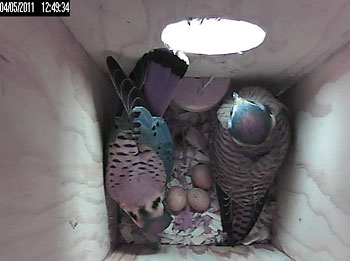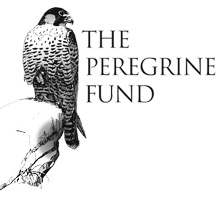Frequently Asked Questions
Keep monitoring and inputting your observations into AKP's database! It is absolutely critical that we receive information on all nestboxes: if partners don’t report boxes that are unoccupied, our data reflects higher occupancy rates than there actually are. We know how discouraging it can be to work hard on a nestbox and see it go unused, but information on where kestrels aren’t is just as valuable as information on where they are. If kestrels aren’t using your boxes we need to know why, and observations from unoccupied boxes are our best clues.
Also, stay patient. It often takes kestrel pairs a year or two to move in, so keep the box up and see what happens. You might try building new boxes and placing them in other spots near the original, to see if different locations, entrance orientations, mounting surfaces, etc. are more attractive to nesting pairs.
Finally, take advantage of our partner network! If kestrels aren’t moving in to any of your boxes and you would still like to visit an occupied nest, try contacting a fellow American Kestrel Partnership researcher in your area to see if they would be willing to take you along on a monitoring visit. This is exactly the collaboration we hope to facilitate through the Partnership, and the visit might give you insight into how you can better attract kestrels to your own box(es).
If non-kestrel species use a nestbox, please report this to us just as you normally would. Again, data on boxes that are not occupied, or are occupied by other species, are absolutely critical to our research. We also encourage you to register the box with the Cornell Lab of Ornithology’s program, which collects nesting data on all bird species.
As European Starlings are an invasive species, many nestbox programs remove their nesting material and eggs from boxes to curb nesting competition. If you do choose to remove starling nests, make sure to record this.
Please note: it is illegal to remove or destroy the eggs, feathers or chicks of any species covered under the Migratory Bird Treaty Act (starlings are not protected under this act). Non-kestrel species will sometimes use kestrel boxes, but please do not remove them. Tell us about them instead!
American Kestrels tend to begin breeding behaviors in early spring - often right around the time when there is no longer a danger of frost in your area. The best way to be sure is to begin observing your nest box from afar! Note the behavior of the adults in the area of the nest box. Key breeding behaviors to watch out for include:
- The Male giving food to the female
- Copulation
- Male and Female entering and exiting the nest box
- The Male bringing food into the nest box
If you see any of the above behaviors, wait for two weeks and then check your box for eggs! American Kestrels tend to lay eggs after about two weeks of courtship.
Look around for hunting territory. Is there plenty of grassy vegetation nearby? How many rodents and insects are found in the area? How many trees are nearby? (kestrels prefer open areas). We also suggest placing nestboxes at least 8-10 feet off the ground, facing in a SE direction, in an area with relatively low human activity. Avoid busy roads.
Do not leave food out for kestrels. You could attract kestrel predators instead.
Researchers and community scientists have been building and monitoring kestrel nestboxes for decades, and in the decades of data generated, there is little to no evidence of adults abandoning nests once eggs are laid because of brief, periodic nest checks by humans. However, monitoring can disturb nesting kestrels if it is undertaken carelessly, so make sure to always keep nestbox visits short.
No permitting is needed to monitor nestboxes, since volunteers must only peek in to count the number of eggs and nestlings. If you plan on any activities that involve touching the birds, however (e.g., banding nestlings, weighing nestlings, or collecting DNA samples), you must apply for appropriate federal and state permits.
We do recommend visiting nestboxes once when there is eggs, and at least once again within 30 days. However, the American Kestrel Partnership is primarily a coordinating entity, not a managing entity, so we leave the details of day-to-day operations up to our partners. Keep in mind that the more often you visit nestboxes the more useful your data will be, but there is no minimum requirement for participation. If you cannot manage frequent visits to nestboxes, it is best to visit once when eggs are present, and then sometime within the next 30 days.
Although kestrels don’t typically hunt songbirds during the nesting season, small birds do know that the falcons are a threat and will avoid areas that they frequent. If you enjoy watching birds on a particular feeder we recommend placing your kestrel nestbox either out of sight or a small distance away.
We also receive questions about how to ensure that kestrels don’t eat feeder birds. While this happens infrequently, it is a possibility—keep in mind that kestrels and songbirds alike are wild species that rely on predator-prey relationships. Kestrels must make a living, and by putting up feeders we invite their prey to visit us. It is natural and healthy that prey species arrive with a few predators in tow.
The Peregrine Fund is supported by donations so of course we appreciate our members’ generosity, but we do not require that community scientists become members to participate in The American Kestrel Partnership.
No. The camera inside the nestbox uses an infrared light source to illuminate the inside of the box. This light can be used by the cameras to create the video picture, but it is invisible to the birds, just as it is to humans.






